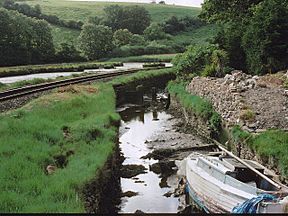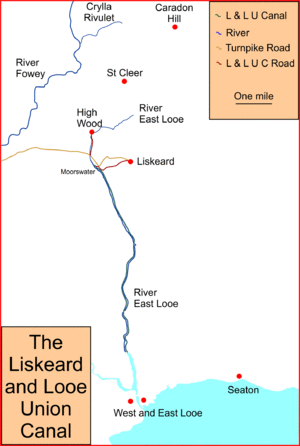Liskeard and Looe Union Canal facts for kids
Quick facts for kids Liskeard and Looe Union Canal |
|
|---|---|

The remains of a lock on the defunct canal
|
|
| Specifications | |
| Locks | 24 |
| Status | defunct |
| History | |
| Principal engineer | Robert Coad |
| Date of act | 1825 |
| Date completed | 1828 |
| Date closed | 1910 |
| Geography | |
| Start point | Liskeard |
| End point | Looe |
| Connects to | River Looe |
The Liskeard and Looe Union Canal was an important waterway in Cornwall, United Kingdom. It connected the town of Liskeard to the port of Looe. The canal was nearly 6 miles (9.7 km) long and had 24 locks. It opened in stages starting in 1827. Robert Coad was the engineer who designed it.
At first, the canal was used to transport sea sand and lime. These materials helped farmers improve the soil for their crops. Later, valuable minerals were found on Caradon Hill. The canal then became very busy, carrying these minerals down to Looe Harbour. The amount of trade grew so much that a railway, the Liskeard and Looe Railway, was built next to the canal. Over time, the canal was used less and less, and eventually it stopped being navigable.
Contents
What Was the Liskeard and Looe Canal Like?
The canal began near the tidal East Looe River, just below Terras Bridge. This was about 1 mile (1.6 km) upstream from Looe bridge. You can still see a bridge over the old canal route today. This bridge was built for the railway line.
The canal generally ran north, following the East Looe River. It stretched for about 5.9 miles (9.5 km). The canal ended at Moorswater, in a valley west of Liskeard. The land rose 156 ft (48 m) along its path, which is why it needed 24 locks. These locks helped boats move up and down the different water levels.
The canal was mostly on the east side of the river. However, it switched sides for a short section. The modern railway line follows the canal's old route very closely.
Why Moorswater Was Chosen
Moorswater was picked as the end point because of its location. It was lower than Liskeard town but close to the farms the canal was meant to serve. New roads were built from Moorswater to Liskeard and to Highwood. These roads helped transport goods further inland.
There was a basin at Moorswater, which was like a small harbor for boats. It was near where the railway crossing is today. A reservoir was also built north of the basin to supply water to the canal.
The canal was designed for barges that could carry up to 20 tonnes of goods. Water for the canal came from the upper parts of the East Looe River and a stream called the Crylla.
When the Canal Stopped Being Used
When the railway line was built in 1860, the canal slowly fell into disrepair. By 1882, maps showed it as "disused." However, a short section near Sandplace continued to be used for a few more years.
Why Was the Canal Built?
The land around the Looe valleys was good for farming. But the soil was acidic and needed lime every year to stay healthy. Traditionally, limestone came from the Plymouth area by ship to the East Looe Valley. There, it was burned in kilns to make lime.
Transporting the lime inland was very difficult. Roads were in poor condition, and goods were often carried on the backs of horses. The first wheeled wagon in the Liskeard area only appeared in 1790. Farmers needed about 10 tonnes of limestone per acre each year. So, moving it was a huge challenge.
Early Ideas for a Canal
The idea for a canal to Liskeard first came up in 1777. Edmund Leach and another gentleman suggested a canal from Banka Mill to Sandplace. This canal would have used "machines" (likely inclined planes) instead of locks. Inclined planes were very new at the time. This early project was estimated to cost £17,495, but it never happened.
After a few other failed plans, a local lawyer named Peter Glubb held a meeting in 1823. They decided to ask engineer James Green for ideas. Green suggested a canal for small, four-ton boats. He also thought about using inclined planes because of the big change in height.
Getting the Canal Approved
People quickly offered money to support the canal. But the plan faced opposition from people in Lostwithiel and Fowey. Also, some of the investors didn't have enough money. The plan was revived the next year, this time for a canal with locks.
To get the support of a powerful landowner, John Buller, the canal would have a wide "Towing Path for Gentlemen's Carriages." This helped the company get their plan approved by Parliament.
James Green prepared the plans for the law. The special Act of Parliament was passed on June 22, 1825. This law created the Liskeard and Looe Union Canal Company. It allowed them to raise £13,000 to build the canal. The Act also said they could take water from the River Looe and the Crylla Rivulet.
Work on the canal started on September 6, 1825. Robert Coad was the engineer. During construction, the company even had a health insurance plan for its workers. This was similar to schemes in Cornish mines.
Opening and Early Years
Part of the canal opened for boats on August 27, 1827. By March 1828, newspapers reported that the canal was fully complete. It climbed 156 ft (48 m) over its 5.9 miles (9.5 km) length.
Even after opening, the company faced challenges. The canal works were "unfinished." It took until 1830 to complete the Moorswater reservoir and the water supply from the Crylla. A new road was also built from Moorswater into Liskeard, costing £1,200. This new road made transport much easier.
Around 1835, the Canal Company built another road. This road connected Looe Mills to Highwood. It further improved access to the canal from surrounding areas.
How the Canal Operated
The canal made it much easier to bring lime and sea sand to farms. It also brought coal for burning lime and for homes. The prices of these goods dropped a lot. However, there wasn't much traffic going downstream, which would have helped balance the loads.
The company managed its money carefully. They paid a 6 percent profit to investors in 1830. After that, they usually paid 5 percent for most of the canal's life. They often reinvested profits into improving the canal.
As trade increased, the Moorswater terminal was expanded. In 1832, a large quay was built. A small railway, called a "railroad," was also built next to it. Local lime kiln owners, William Hodge and John Lyne, built their own small railways. These connected their kilns to the canal basin.
By 1835, the canal's condition was again a concern. The company tried to fix problems, but it took many years. From 1842, the company worried about falling income. This was due to a general downturn in farming. Competition from other areas also affected them. The company often lowered the fees for using the canal.
The Impact of Mining on Caradon Hill
In 1836, copper ore was found on Caradon Hill. As more ore was mined, it needed to be transported. Moving minerals by pack horse was slow and expensive. So, the Liskeard and Caradon Railway was built to bring the ore to Moorswater. The Canal Company made space for the railway at their terminal.
The railway reached Moorswater on March 8, 1846. From then on, the ore was carried to Looe on the canal. This completely changed the canal's business. Minerals could now reach markets easily: by railway to Moorswater, then by canal boat to Looe, and finally by ship. This not only brought more business to the canal but also encouraged more mining. The mines also needed coal and iron, which also traveled on the canal.
This huge increase in traffic meant the wharves at Moorswater had to be greatly expanded. There were also worries about having enough water for the locks. The canal company had arguments with mill owners further up the East Looe Valley about water use.
Some records show how much was carried:
- In 1849, 21,713 tons were carried. This included 7,546 tons of copper ore and 6,175 tons of coal.
- In 1859, 48,193 tons were carried. This included 17,361 tons of copper ore, 15,712 tons of coal, and 8,297 tons of granite.
Building a Railway Alongside the Canal
By the late 1850s, the canal was very busy. Transferring goods from the railway to the canal at Moorswater was costly. The canal was often congested, meaning trade was lost to other routes. Also, the 24 locks made journeys slow. The new Cornwall Railway was being built through Liskeard, which might also affect the canal's business. People started thinking about building a railway from Moorswater to Looe.
A report in 1857 suggested building a railway for £11,000. This idea was quickly approved. Despite some opposition, the Duchy of Cornwall helped the company get permission. The Liskeard and Looe Railway Act was passed on May 11, 1858. This allowed the Canal Company to raise more money for the railway.
The railway opened for goods traffic on December 27, 1860. Passenger trains started running in 1879. You can read more about it in the article Liskeard and Looe Railway.
The Canal After the Railway Was Built
The new railway did not replace the canal's exact path. It crossed the canal in five places using bridges. However, the railway seems to have covered up the canal at its northern end. Sandplace remained an important wharf for the canal for a while. But the canal above Sandplace was allowed to decline.
Even though the canal was still officially open, the Liskeard Water Company took over its water supply from May 1861. Without water at the top, only the lower section of the canal could be used. Repairs were still done on the lower section between 1862 and 1867. But it's likely the upper part was no longer navigable. By 1867, people complained that the canal could no longer be used since the railway was built.
The canal continued to decline. Only small boats could use it. Between 1901 and 1909, the canal earned very little money each year. This came mostly from small boats carrying sand and seaweed. Two of the original 16-ton boats were still used for journeys to Sandplace.
The Great Western Railway bought the Canal company in 1909. They wanted the railway line, especially for passenger traffic and tourism. The Liskeard and Caradon Railway closed in 1917. But the Liskeard and Looe Railway still operates today. Passenger trains on this line are known as "The Looe Valley Line".
Efforts to Preserve the Canal
Towards the end of the 20th century, people became interested in preserving what was left of the canal. In 1988, a group called the Inland Waterways Association created a walking guide for the canal. They hoped to get more people interested in it.
In 1997, the local council announced plans to partly restore the remains of the canal. This restoration would not make it navigable again. However, it is not clear if this work was actually carried out.
Images for kids




